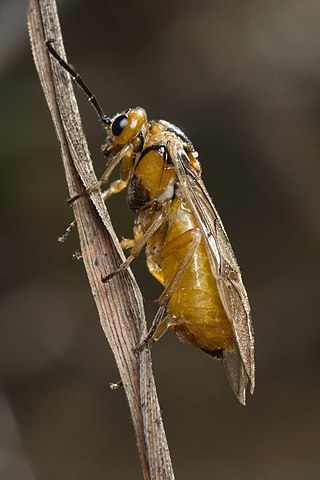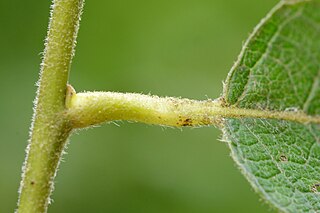
Euura is a genus of sawflies of the family Tenthredinidae, subfamily Nematinae. Some of the larvae feed externally on plants and some form plant galls on willows (Salix species). In the case of the gall-forming species, when the female lays her eggs she injects a stimulant and the gall starts to form before the eggs hatch. Most sawfly galls are hard and individual larva tend to inhabit the gall, feeding on the tissue and leave the gall to pupate in the soil. Most of the species are monophages although the type species, Euura mucronata, is polyphagous feeding on over thirty species of willow.
Euura amerinae is a species of sawfly belonging to the family Tenthredinidae. The larvae form galls on bay willow. It was first described by Carl Linnaeus in 1758.

Euura atra is a species of sawfly belonging to the family Tenthredinidae. The larvae feed internally on the shoots of willows and do not usually form galls, although it is included in plant gall literature such as British Plant Galls. It was first described by Louis Jurine in 1807. E. atra is one of a number of closely related species known as the Euura atra subgroup.
Euura auritae is a species of sawfly belonging to the family Tenthredinidae. The larvae forms galls on willows. It was first described by Jens-Peter Kopelke in 2000. E. auritae is one of a number of closely related species which is known as the Euura atra subgroup.
Euura weiffenbachiella is a species of sawfly belonging to the family Tenthredinidae. The larvae forms galls on creeping willows. E. weiffenbachiella is one of a number of closely related species which is known as the Euura atra subgroup.
Euura salicispurpureae is a species of sawfly belonging to the family Tenthredinidae. It was first described by Jens-Peter Kopelke in 2014. The larvae feed within galls on willows. E. salicispurpureae is one of a number of closely related species known as the Euura atra subgroup.
Euura myrtilloides is a species of sawfly belonging to the family Tenthredinidae and the larvae forms galls on swamp willow. It was first described by Jens-Peter Kopelke in 1996. E. myrtilloides is one of a number of closely related species which is known as the Euura atra subgroup.
Euura destricta is a species of sawfly belonging to the family Tenthredinidae. The larvae feed on the leaves of willow.

Euura venusta is a species of sawfly belonging to the family Tenthredinidae. The larvae feed within the leaf-stalk of willows forming a gall. The sawfly was first described by Carl Gustav Alexander Brischke in 1883.
Euura testaceipes is a species of sawfly belonging to the family Tenthredinidae. The larvae feed within the leaf-stalk (petiole), or midrib of a leaf, on willows forming a gall. The sawfly was first described by Carl Gustav Alexander Brischke in 1883. E. testaceipes is one of three closely related species known as the Euura amerinae species subgroup. The other members of the group are E. amerinae and E. venusta
Euura nigricantis is a species of sawfly belonging to the family Tenthredinidae. The larvae feed within galls on the leaves of dark-leaved willow. It was first described by Jens-Peter Kopelke in 1986.
Euura triandrae is a species of sawfly belonging to the family Tenthredinidae. The larvae feed on the leaves of almond willow and was first described in 1941.
Euura vesicator is a species of sawfly belonging to the family Tenthredinidae. The larvae feed internally in a gall on the leaves of purple willow and its hybrids. It was first described by Johann Jacob Bremi-Wolf in 1849.
Euura pustulator is a species of sawfly belonging to the family Tenthredinidae. The larvae feed internally in a gall formed on the leaves of tea-leaved willow and diamondleaf willow.
Euura herbaceae is a species of sawfly belonging to the family Tenthredinidae. The larvae feed internally in a gall formed on the leaves of dwarf willow and polar willow. Galls of E. aquilonis are similar and the larvae need to be examined to tell them apart.
Euura aquilonis is a species of sawfly belonging to the family Tenthredinidae. The larvae feed internally in a gall formed on the leaves of dwarf willow and polar willow. Galls of E. herbaceae are similar and the larvae need to be examined to tell them apart.
Euura arbusculae is a species of sawfly belonging to the family Tenthredinidae. The larvae feed internally in a gall formed on the leaves of mountain willow.
Euura crassipes is a species of sawfly belonging to the family Tenthredinidae and was first described by Carl Gustaf Thomson in 1871. The larvae feed internally in a gall formed on the leaves of downy willow.
Euura collactanea is a species of sawfly belonging to the family Tenthredinidae. The larva feed within galls on the leaves of willows. It was first described by Arnold Förster in 1854.

Pontania proxima, the willow gall sawfly, is native to Europe and Western Asia and makes prominent red galls on the leaves of willows. It is also now widespread in New Zealand, after arriving in Canterbury in 1929, and was successfully introduced to Australia.




